International Space Station
| |||
| Station statistics | |||
|---|---|---|---|
| COSPAR ID | 1998-067A | ||
| Call sign | Alpha, Station | ||
| Crew | Fully crewed: 6 Currently aboard: 3 (Expedition 49) | ||
| Launch | 20 November 1998 | ||
| Launch pad | Baikonur 1/5 and 81/23 Kennedy LC-39 | ||
| Mass |  419,455 kg (924,740 lb) 419,455 kg (924,740 lb) | ||
| Length | 72.8 m (239 ft) | ||
| Width | 108.5 m (356 ft) | ||
| Height |  20 m (66 ft) 20 m (66 ft)nadir–zenith, arrays forward–aft (27 November 2009) | ||
| Pressurised volume | 931.57 m3 (32,898 cu ft) (28 May 2016) | ||
| Atmospheric pressure | 101.3 kPa (29.91 inHg, 1 atm) | ||
| Perigee | 409 km (254 mi) AMSL | ||
| Apogee | 416 km (258 mi) AMSL | ||
| Orbital inclination | 51.65 degrees | ||
| Orbital speed | 7.66 kilometres per second (27,600 km/h; 17,100 mph) | ||
| Orbital period | 92.69 minutes | ||
| Orbit epoch | 25 January 2015 | ||
| Days in orbit | 17 years, 306 days (21 September) | ||
| Days occupied | 15 years, 324 days (21 September) | ||
| Number of orbits | 101,081 As of July 2016 | ||
| Orbital decay | 2 km/month | ||
Configuration | |||
| |||
The ISS serves as a microgravity and space environment research laboratory in which crew members conduct experiments in biology, human biology, physics, astronomy, meteorology, and other fields. The station is suited for the testing of spacecraft systems and equipment required for missions to the Moon and Mars. The ISS maintains an orbit with an altitude of between 330 and 435 km (205 and 270 mi) by means of reboost manoeuvres using the engines of the Zvezda module or visiting spacecraft. It completes 15.54 orbits per day.
The ISS is the ninth space station to be inhabited by crews, following the Soviet and later Russian Salyut, Almaz, and Mir stations as well as Skylab from the US. The station has been continuously occupied for 15 years and 324 days since the arrival of Expedition 1 on 2 November 2000. This is the longest continuous human presence in low Earth orbit, having surpassed the previous record of 9 years and 357 days held by Mir. The station is serviced by a variety of visiting spacecraft: the Russian Soyuz and Progress, the American Dragon and Cygnus, the Japanese H-II Transfer Vehicle, and formerly the Space Shuttle and the European Automated Transfer Vehicle. It has been visited by astronauts, cosmonauts and space tourists from 17 different nations.
After the US Space Shuttle programme ended in 2011, Soyuz rockets became the only provider of transport for astronauts at the International Space Station, and Dragon became the only provider of bulk cargo return to Earth services (downmass capability of Soyuz capsules is very limited).
The ISS programme is a joint project among five participating space agencies: NASA, Roscosmos, JAXA, ESA, and CSA. The ownership and use of the space station is established by intergovernmental treaties and agreements. The station is divided into two sections, the Russian Orbital Segment (ROS) and the United States Orbital Segment (USOS), which is shared by many nations. As of January 2014, the American portion of ISS is being funded until 2024.Roscosmos has endorsed the continued operation of ISS through 2024, but has proposed using elements of the Russian Orbital Segment to construct a new Russian space station called OPSEK.
On 28 March 2015, Russian sources announced that Roscosmos and NASA had agreed to collaborate on the development of a replacement for the current ISS. NASA later issued a guarded statement expressing thanks for Russia's interest in future cooperation in space exploration, but fell short of confirming the Russian announcement.
Purpose
Fisheye view of several labs |
CubeSats are deployed by the NanoRacks CubeSat Deployer attached to the end of the Japanese robotic arm |
Scientific research
The ISS provides a platform to conduct scientific research. Small unmanned spacecraft can provide platforms for zero gravity and exposure to space, but space stations offer a long-term environment where studies can be performed potentially for decades, combined with ready access by human researchers over periods that exceed the capabilities of manned spacecraft.The ISS simplifies individual experiments by eliminating the need for separate rocket launches and research staff. The wide variety of research fields include astrobiology, astronomy, human research including space medicine and life sciences, physical sciences, materials science, space weather, and weather on Earth (meteorology). Scientists on Earth have access to the crew's data and can modify experiments or launch new ones, which are benefits generally unavailable on unmanned spacecraft. Crews fly expeditions of several months duration, providing approximately 160-man-hours per week of labour with a crew of 6.
To detect dark matter and answer other fundamental questions about our universe, engineers and scientists from all over the world built the Alpha Magnetic Spectrometer (AMS), which NASA compares to the Hubble space telescope, and says could not be accommodated on a free flying satellite platform partly because of its power requirements and data bandwidth needs. On 3 April 2013, NASA scientists reported that hints of dark matter may have been detected by the Alpha Magnetic Spectrometer. According to the scientists, "The first results from the space-borne Alpha Magnetic Spectrometer confirm an unexplained excess of high-energy positrons in Earth-bound cosmic rays."
Comet Lovejoy photographed by Expedition 30 commander Dan Burbank |
The space environment is hostile to life. Unprotected presence in space is characterised by an intense radiation field (consisting primarily of protons and other subatomic charged particles from the solar wind, in addition to cosmic rays), high vacuum, extreme temperatures, and microgravity. Some simple forms of life called extremophiles, including small invertebrates called tardigrades can survive in this environment in an extremely dry state called desiccation.
Medical research improves knowledge about the effects of long-term space exposure on the human body, including muscle atrophy, bone loss, and fluid shift. This data will be used to determine whether lengthy human spaceflight and space colonisation are feasible. As of 2006, data on bone loss and muscular atrophy suggest that there would be a significant risk of fractures and movement problems if astronauts landed on a planet after a lengthy interplanetary cruise, such as the six-month interval required to travel to Mars. Medical studies are conducted aboard the ISS on behalf of the National Space Biomedical Research Institute (NSBRI). Prominent among these is the Advanced Diagnostic Ultrasound in Microgravity study in which astronauts perform ultrasound scans under the guidance of remote experts. The study considers the diagnosis and treatment of medical conditions in space. Usually, there is no physician on board the ISS and diagnosis of medical conditions is a challenge. It is anticipated that remotely guided ultrasound scans will have application on Earth in emergency and rural care situations where access to a trained physician is difficult.
Microgravity
A comparison between the combustion of a candle on Earth (left) and in a microgravity environment, such as that found on the ISS (right) |
- Drag from the residual atmosphere; when the ISS enters the Earth's shadow, the main solar panels are rotated to minimise this aerodynamic drag, helping reduce orbital decay.
- Vibration from movements of mechanical systems and the crew.
- Actuation of the on-board attitude control moment gyroscopes.
- Thruster firings for attitude or orbital changes.
- Gravity-gradient effects, also known as tidal effects. Items at different locations within the ISS would, if not attached to the station, follow slightly different orbits. Being mechanically interconnected these items experience small forces that keep the station moving as a rigid body.
ISS crew member storing samples |
The investigation of the physics of fluids in microgravity will allow researchers to model the behaviour of fluids better. Because fluids can be almost completely combined in microgravity, physicists investigate fluids that do not mix well on Earth. In addition, an examination of reactions that are slowed by low gravity and temperatures will give scientists a deeper understanding of superconductivity.
The study of materials science is an important ISS research activity, with the objective of reaping economic benefits through the improvement of techniques used on the ground. Other areas of interest include the effect of the low gravity environment on combustion, through the study of the efficiency of burning and control of emissions and pollutants. These findings may improve current knowledge about energy production, and lead to economic and environmental benefits. Future plans are for the researchers aboard the ISS to examine aerosols, ozone, water vapour, and oxides in Earth's atmosphere, as well as cosmic rays, cosmic dust, antimatter, and dark matter in the universe.
Exploration
A 3D plan of the Russia-based MARS-500 complex, used for ground-based experiments which complement ISS-based preparations for a manned mission to Mars |
In 2009, noting the value of the partnership framework itself, Sergey Krasnov wrote, "When compared with partners acting separately, partners developing complementary abilities and resources could give us much more assurance of the success and safety of space exploration. The ISS is helping further advance near-Earth space exploration and realisation of prospective programmes of research and exploration of the Solar system, including the Moon and Mars." A manned mission to Mars may be a multinational effort involving space agencies and countries outside the current ISS partnership. In 2010, ESA Director-General Jean-Jacques Dordain stated his agency was ready to propose to the other four partners that China, India and South Korea be invited to join the ISS partnership. NASA chief Charlie Bolden stated in February 2011, "Any mission to Mars is likely to be a global effort". Currently, American legislation prevents NASA co-operation with China on space projects.
Education and cultural outreach
Japan's Kounotori 4 berthing |
JAXA aims both to "Stimulate the curiosity of children, cultivating their spirits, and encouraging their passion to pursue craftsmanship", and to "Heighten the child's awareness of the importance of life and their responsibilities in society." Through a series of education guides, a deeper understanding of the past and near-term future of manned space flight, as well as that of Earth and life, will be learned. In the JAXA Seeds in Space experiments, the mutation effects of spaceflight on plant seeds aboard the ISS is explored. Students grow sunflower seeds which flew on the ISS for about nine months as a start to 'touch the Universe'. In the first phase of Kibō utilisation from 2008 to mid-2010, researchers from more than a dozen Japanese universities conducted experiments in diverse fields.
Original Jules Verne manuscripts displayed by crew inside Jules Verne ATV |
Amateur Radio on the ISS (ARISS) is a volunteer programme which encourages students worldwide to pursue careers in science, technology, engineering and mathematics through amateur radio communications opportunities with the ISS crew. ARISS is an international working group, consisting of delegations from nine countries including several countries in Europe as well as Japan, Russia, Canada, and the United States. In areas where radio equipment cannot be used, speakerphones connect students to ground stations which then connect the calls to the station.
First Orbit is a feature-length documentary film about Vostok 1, the first manned space flight around the Earth. By matching the orbit of the International Space Station to that of Vostok 1 as closely as possible, in terms of ground path and time of day, documentary filmmaker Christopher Riley and ESA astronaut Paolo Nespoli were able to film the view that Yuri Gagarin saw on his pioneering orbital space flight. This new footage was cut together with the original Vostok 1 mission audio recordings sourced from the Russian State Archive. Nespoli, during Expedition 26/27, filmed the majority of the footage for this documentary film, and as a result is credited as its director of photography. The film was streamed through the website firstorbit.org in a global YouTube premiere in 2011, under a free license.
In May 2013, commander Chris Hadfield shot a music video of David Bowie's "Space Oddity" on board the station; the film was released freely on YouTube. It was the first music video ever to be filmed in space.
Assembly
Partially constructed ISS in December 2002 |
 |
S3-S4 Truss Installed in 2007 |
Soyuz TMA-19 departs in 2010 |
 |
ISS in 2007, with fewer solar arrays |
The first module of the ISS, Zarya, was launched on 20 November 1998 on an autonomous Russian Proton rocket. It provided propulsion, attitude control, communications, electrical power, but lacked long-term life support functions. Two weeks later a passive NASA module Unity was launched aboard Space Shuttle flight STS-88 and attached to Zarya by astronauts during EVAs. This module has two Pressurized Mating Adapters (PMAs), one connects permanently to Zarya, the other allows the Space Shuttle to dock to the space station. At this time, the Russian station Mir was still inhabited. The ISS remained unmanned for two years, during which time Mir was de-orbited. On 12 July 2000 Zvezda was launched into orbit. Preprogrammed commands on board deployed its solar arrays and communications antenna. It then became the passive vehicle for a rendezvous with the Zarya and Unity. As a passive "target" vehicle, the Zvezda maintained a stationkeeping orbit as the Zarya-Unity vehicle performed the rendezvous and docking via ground control and the Russian automated rendezvous and docking system. Zarya's computer transferred control of the station to Zvezda's computer soon after docking. Zvezda added sleeping quarters, a toilet, kitchen, CO2 scrubbers, dehumidifier, oxygen generators, exercise equipment, plus data, voice and television communications with mission control. This enabled permanent habitation of the station.
The first resident crew, Expedition 1, arrived in November 2000 on Soyuz TM-31. At the end of the first day on the station, astronaut Bill Shepherd requested the use of the radio call sign "Alpha", which he and cosmonaut Krikalev preferred to the more cumbersome "International Space Station". The name "Alpha" had previously been used for the station in the early 1990s, and following the request, its use was authorised for the whole of Expedition 1. Shepherd had been advocating the use of a new name to project managers for some time. Referencing a naval tradition in a pre-launch news conference he had said: "For thousands of years, humans have been going to sea in ships. People have designed and built these vessels, launched them with a good feeling that a name will bring good fortune to the crew and success to their voyage." Yuri Semenov, the President of Russian Space Corporation Energia at the time, disapproved of the name "Alpha"; he felt that Mir was the first space station, and so he would have preferred the names "Beta" or "Mir 2" for the ISS.
Expedition 1 arrived midway between the flights of STS-92 and STS-97. These two Space Shuttle flights each added segments of the station's Integrated Truss Structure, which provided the station with Ku-band communication for US television, additional attitude support needed for the additional mass of the USOS, and substantial solar arrays supplementing the station's existing 4 solar arrays.
Over the next two years, the station continued to expand. A Soyuz-U rocket delivered the Pirs docking compartment. The Space Shuttles Discovery, Atlantis, and Endeavour delivered the Destiny laboratory and Quest airlock, in addition to the station's main robot arm, the Canadarm2, and several more segments of the Integrated Truss Structure.
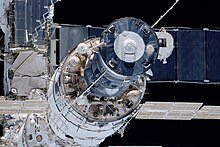 |
Aft view showing a Progress spacecraft docked to Zvezda |
Assembly resumed in 2006 with the arrival of STS-115 with Atlantis, which delivered the station's second set of solar arrays. Several more truss segments and a third set of arrays were delivered on STS-116, STS-117, and STS-118. As a result of the major expansion of the station's power-generating capabilities, more pressurised modules could be accommodated, and the Harmony node and Columbus European laboratory were added. These were followed shortly after by the first two components of Kibō. In March 2009, STS-119 completed the Integrated Truss Structure with the installation of the fourth and final set of solar arrays. The final section of Kibō was delivered in July 2009 on STS-127, followed by the Russian Poisk module. The third node, Tranquility, was delivered in February 2010 during STS-130 by the Space Shuttle Endeavour, alongside the Cupola, closely followed in May 2010 by the penultimate Russian module, Rassvet. Rassvet was delivered by Space Shuttle Atlantis on STS-132 in exchange for the Russian Proton delivery of the Zarya Module in 1998 which had been funded by the United States. The last pressurised module of the USOS, Leonardo, was brought to the station by Discovery on her final flight, STS-133, followed by the Alpha Magnetic Spectrometer on STS-134, delivered by Endeavour.
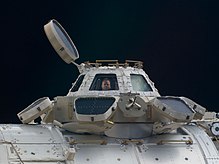 |
The Cupola arrived in 2010 |
The gross mass of the station changes over time. The total launch mass of the modules on orbit is about 417,289 kg (919,965 lb) (as of 3 September 2011). The mass of experiments, spare parts, personal effects, crew, foodstuff, clothing, propellants, water supplies, gas supplies, docked spacecraft, and other items add to the total mass of the station. Hydrogen gas is constantly vented overboard by the oxygen generators.
Station structure
 |
Russian Orbital Segment Windows |
 |
USOS International Space Station window locations |
The ISS is a third generation modular space station. Modular stations can allow the mission to be changed over time and new modules can be added or removed from the existing structure, allowing greater flexibility.
Below is a diagram of major station components. The blue areas are pressurised sections accessible by the crew without using spacesuits. The station's unpressurised superstructure is indicated in red. Other unpressurised components are yellow. Note that the Unity node joins directly to the Destiny laboratory. For clarity, they are shown apart.
| Russian docking port | |||||||||||||||||||||||||||||||||||||||||||||||||||||
| Solar array | Zvezda DOS-8 (service module) | Solar array | |||||||||||||||||||||||||||||||||||||||||||||||||||
| Russian docking port | Poisk (MRM-2) airlock | Pirs airlock | Russian docking port | ||||||||||||||||||||||||||||||||||||||||||||||||||
| Nauka lab to replace Pirs | European robotic arm | ||||||||||||||||||||||||||||||||||||||||||||||||||||
| Solar array | Zarya FGB (first module) | Solar array | |||||||||||||||||||||||||||||||||||||||||||||||||||
| Rassvet (MRM-1) | Russian docking port | ||||||||||||||||||||||||||||||||||||||||||||||||||||
| PMA 1 | |||||||||||||||||||||||||||||||||||||||||||||||||||||
| Cargo spacecraft berthing port | Leonardo cargo bay | BEAM habitat | |||||||||||||||||||||||||||||||||||||||||||||||||||
| Quest airlock | Unity Node 1 | Tranquility Node 3 | PMA 3 docking port | ||||||||||||||||||||||||||||||||||||||||||||||||||
| ESP-2 | Cupola | ||||||||||||||||||||||||||||||||||||||||||||||||||||
| Solar array | Solar array | Heat radiator | Heat radiator | Solar array | Solar array | ||||||||||||||||||||||||||||||||||||||||||||||||
| ELC 2, AMS | Z1 truss | ELC 3 | |||||||||||||||||||||||||||||||||||||||||||||||||||
| S5/6 Truss | S3/S4 Truss | S1 Truss | S0 Truss | P1 Truss | P3/P4 Truss | P5/6 Truss | |||||||||||||||||||||||||||||||||||||||||||||||
| ELC 4, ESP 3 | ELC 1 | ||||||||||||||||||||||||||||||||||||||||||||||||||||
| Dextre robotic arm | Canadarm2 robotic arm | ||||||||||||||||||||||||||||||||||||||||||||||||||||
| Solar array | Solar array | Solar array | Solar array | ||||||||||||||||||||||||||||||||||||||||||||||||||
| ESP-1 | Destiny laboratory | ||||||||||||||||||||||||||||||||||||||||||||||||||||
| Kibō logistics cargo bay | |||||||||||||||||||||||||||||||||||||||||||||||||||||
| Cargo spacecraft berthing port | Cargo spacecraft berthing port | ||||||||||||||||||||||||||||||||||||||||||||||||||||
| Kibō robotic arm | |||||||||||||||||||||||||||||||||||||||||||||||||||||
| External payloads | Columbus laboratory | Harmony Node 2 | Kibō laboratory | Kibō external platform | |||||||||||||||||||||||||||||||||||||||||||||||||
| PMA 2 docking port | |||||||||||||||||||||||||||||||||||||||||||||||||||||
| IDA 2 docking adapter | |||||||||||||||||||||||||||||||||||||||||||||||||||||
Pressurised modules
Zarya
 |
Zarya as seen by Space Shuttle Endeavour during STS-88 |
Built from December 1994 to January 1998 in Russia at the Khrunichev State Research and Production Space Center (KhSC) in Moscow, Zarya's control system was developed by the Khartron Corp. (Kharkiv, Ukraine).
Zarya was launched on 20 November 1998, on a Russian Proton rocket from Baikonur Cosmodrome Site 81 in Kazakhstan to a 400 km (250 mi) high orbit with a designed lifetime of at least 15 years. After Zarya reached orbit, STS-88 launched on 4 December 1998, to attach the Unity Module.
Although only designed to fly autonomously for six to eight months, Zarya did so for almost two years because of delays with the Russian Service Module, Zvezda, which finally launched on 12 July 2000, and docked with Zarya on 26 July using the Russian Kurs docking system.
Unity
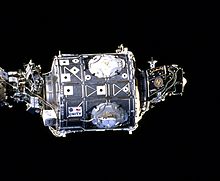 |
Unity as pictured by Space Shuttle Endeavour |
Unity was carried into orbit as the primary cargo of the Space Shuttle Endeavour on STS-88, the first Space Shuttle mission dedicated to assembly of the station. On 6 December 1998, the STS-88 crew mated the aft berthing port of Unity with the forward hatch of the already orbiting Zarya module.
Zvezda
Zvezda (Russian: Звезда́, meaning "star"), also known as DOS-8, Service Module or SM (Russian: СМ). Early in the station's life, Zvezda provided all of its critical systems. It made the station permanently habitable for the first time, adding life support for up to six crew and living quarters for two. Zvezda's DMS-R computer handles guidance, navigation and control for the entire space station. A second computer which performs the same functions will be installed in the Nauka module, FGB-2.The hull of Zvezda was completed in February 1985, with major internal equipment installed by October 1986. The module was launched by a Proton-K rocket from Site 81/23 at Baikonur, on 12 July 2000. Zvezda is at the rear of the station according to its normal direction of travel and orientation, and its engines may be used to boost the station's orbit. Alternatively Russian and European spacecraft can dock to Zvezda's aft port and use their engines to boost the station.
Destiny
 |
Destiny interior in 2001 |
Quest
Quest is the only USOS airlock, and hosts spacewalks with both United States EMU and Russian Orlan spacesuits. It consists of two segments: the equipment lock, which stores spacesuits and equipment, and the crew lock, from which astronauts can exit into space. This module has a separately controlled atmosphere. Crew sleep in this module, breathing a low nitrogen mixture the night before scheduled EVAs, to avoid decompression sickness (known as "the bends") in the low-pressure suits.Pirs and Poisk
Pirs (Russian: Пирс, meaning "pier"), (Russian: Стыковочный отсек), "docking module", SO-1 or DC-1 (docking compartment), and Poisk (Russian: По́иск; lit. Search), also known as the Mini-Research Module 2 (MRM 2), Малый исследовательский модуль 2, or МИМ 2. Pirs and Poisk are Russian airlock modules. Each of these modules have 2 identical hatches. An outward opening hatch on the MIR space station failed after it swung open too fast after unlatching, because of a small amount of air pressure remaining in the airlock. A different entry was used, and the hatch repaired. All EVA hatches on the ISS open inwards and are pressure sealing. Pirs was used to store, service, and refurbish Russian Orlan suits and provided contingency entry for crew using the slightly bulkier American suits. The outermost docking ports on both airlocks allow docking of Soyuz and Progress spacecraft, and the automatic transfer of propellants to and from storage on the ROS.Harmony
Harmony is the second of the station's node modules and the utility hub of the USOS. The module contains four racks that provide electrical power, bus electronic data, and acts as a central connecting point for several other components via its six Common Berthing Mechanisms (CBMs). The European Columbus and Japanese Kibō laboratories are permanently berthed to the starboard and port radial ports respectively. The nadir and zenith ports can be used for docking visiting spacecraft including HTV, Dragon, and Cygnus, with the nadir port serving as the primary docking port. American Shuttle Orbiters docked with the ISS via PMA-2, attached to the forward port.Tranquility
Tranquility is the third and last of the station's US nodes, it contains an additional life support system to recycle waste water for crew use and supplements oxygen generation. Like the other US nodes, it has six berthing mechanisms, five of which are currently in use. The first one connects to the station's core via the Unity module, others host the Cupola, the PMA docking port #3, the Leonardo PMM and the Bigelow Expandable Activity Module. The final zenith port remains free.Columbus
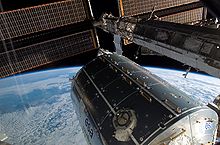 |
Columbus module in 2008 |
Kibō
 |
Not large enough for crew using spacesuits, the airlock on Kibō has a sliding drawer for external experiments. |
 Pressurized Module
Pressurized Module Experiment Logistics Module
Experiment Logistics Module Exposed Facility
Exposed Facility Experiment Logistics Module
Experiment Logistics Module Remote Manipulator System
Remote Manipulator System
Cupola
Cupola is a seven window observatory, used to view Earth and docking spacecraft. Its name derives from the Italian word cupola, which means "dome". The Cupola project was started by NASA and Boeing, but cancelled because of budget cuts. A barter agreement between NASA and the ESA resulted in the Cupola's development being resumed in 1998 by the ESA. It was built by Thales Alenia Space in Torino, Italy. The module
comes equipped with robotic workstations for operating the station's main robotic arm and shutters to protect its windows from damage caused by micrometeorites. It features 7 windows, with an 80-centimetre (31 in) round window, the largest window on the station (and the largest flown in space to date). The distinctive design has been compared to the 'turret' of the fictitious Millennium Falcon from the motion picture Star Wars; the original prop lightsaber used by actor Mark Hamill as Luke Skywalker in the 1977 film was flown to the station in 2007.
Rassvet
Rassvet (Russian: Рассве́т; lit. "dawn"), also known as the Mini-Research Module 1 (MRM-1) (Russian: Ма́лый иссле́довательский модуль, МИМ 1) and formerly known as the Docking Cargo Module (DCM), is similar in design to the Mir Docking Module launched on STS-74 in 1995. Rassvet is primarily used for cargo storage and as a docking port for visiting spacecraft. It was flown to the ISS aboard NASA's Space Shuttle Atlantis on the STS-132 mission and connected in May 2010, Rassvet is the only Russian owned module launched by NASA, to repay for the launch of Zarya, which is Russian designed and built, but partially paid for by NASA. Rassvet was launched with the Russian Nauka Laboratory's Experiments airlock temporarily attached to it, and spare parts for the European Robotic Arm.Leonardo
 |
Leonardo installed |
Bigelow Expandable Activity Module
On 16 January 2013, Bigelow Aerospace was contracted by NASA to provide a Bigelow Expandable Activity Module (BEAM) for a two-year technology demonstration. BEAM was delivered to the ISS aboard SpaceX CRS-8 on 10 April 2016, and was berthed to the aft port of the Tranquility node on 16 April.During its two-year test run, instruments are expected to measure its structural integrity and leak rate, along with temperature and radiation levels. The hatch leading into the module will remain mostly closed except for periodic visits by space station crew members for inspections and data collection. Following the test run, the module will be detached and jettisoned from the station.
Scheduled additional modules
Nauka
Nauka (Russian: Нау́ка; lit. "science"), also known as the Multipurpose Laboratory Module (MLM) or FGB-2 (Russian: Многофункциональный лабораторный модуль, МЛМ), is the major Russian laboratory module. It was scheduled to arrive at the station in 2014, docking to the port that was occupied by the Pirs module. Due to deteriorations following many years spent in storage, it proved necessary to build a new propulsion module, and the launch date was postponed to November 2017. Prior to the arrival of the Nauka module, a Progress spacecraft will remove Pirs from the station, deorbiting it to reenter over the Pacific Ocean. Nauka contains an additional set of life support systems and attitude control. Originally it would have routed power from the single Science-and-Power Platform, but that single module design changed over the first ten years of the ISS mission, and the two science modules, which attach to Nauka via the Uzlovoy Module, or Russian node, each incorporate their own large solar arrays to power Russian science experiments in the ROS.Nauka's mission has changed over time. During the mid-1990s, it was intended as a backup for the FGB, and later as a universal docking module (UDM); its docking ports will be able to support automatic docking of both spacecraft, additional modules and fuel transfer. Nauka has its own engines. Smaller Russian modules such as Pirs and Poisk were delivered by modified Progress spacecraft, and the larger modules; Zvezda, Zarya, and Nauka, were launched by Proton rockets. Russia plans to separate Nauka, along with the rest of the Russian Orbital Segment, before the ISS is deorbited, to form the OPSEK space station.
Uzlovoy Module
The Uzlovoy Module (UM), or Node Module is a 4 metric ton ball shaped module that will support the docking of two scientific and power modules during the final stage of the station assembly and provide the Russian segment additional docking ports to receive Soyuz TMA and Progress M spacecraft. UM is to be incorporated into the ISS in 2016. It will be integrated with a special version of the Progress cargo ship and launched by a standard Soyuz rocket. The Progress would use its own propulsion and flight control system to deliver and dock the Node Module to the nadir (Earth-facing) docking port of the Nauka MLM/FGB-2 module. One port is equipped with an active hybrid docking port, which enables docking with the MLM module. The remaining five ports are passive hybrids, enabling docking of Soyuz and Progress vehicles, as well as heavier modules and future spacecraft with modified docking systems. The node module was conceived to serve as the only permanent element of the future Russian successor to the ISS, OPSEK. Equipped with six docking ports, the Node Module would serve as a single permanent core of the future station with all other modules coming and going as their life span and mission required. This would be a progression beyond the ISS and Russia's modular MIR space station, which are in turn more advanced than early monolithic first generation stations such as Skylab, and early Salyut and Almaz stations.Science Power Modules 1 & 2 (NEM-1, NEM-2) (Russian: Нау́чно-Энергетический Модуль-1 и -2)
 |
The cancelled Habitation module under construction in 1997 |



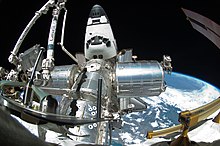






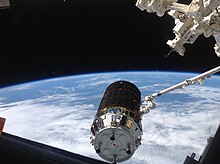
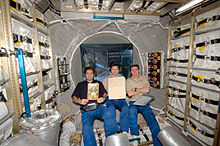
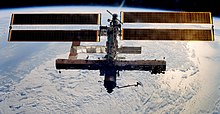








No comments:
Post a Comment